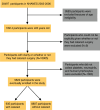Predictive role of the peripheral blood inflammation indices neutrophil-to-lymphocyte ratio (NLR), platelet-to-lymphocyte ratio (PLR), and systemic immunoinflammatory index (SII) for age-related cataract risk
- PMID: 39556543
- PMCID: PMC11573120
- DOI: 10.1371/journal.pone.0313503
Predictive role of the peripheral blood inflammation indices neutrophil-to-lymphocyte ratio (NLR), platelet-to-lymphocyte ratio (PLR), and systemic immunoinflammatory index (SII) for age-related cataract risk
Abstract
The novel inflammatory markers neutrophil-to-lymphocyte ratio (NLR), platelet-to-lymphocyte ratio (PLR), and systemic immunoinflammatory index (SII) have not yet been used in the study of age-related cataracts. The aim of this study was to investigate the possible relationships between the NLR, PLR, and SII and age-related cataracts. In the 2005-2008 National Health and Nutrition Examination Survey (NHANES) cross-sectional surveys, we collected complete information on blood counts, whether cataract surgery had been performed, and baseline information for adults. We investigated the independent interactions between the inflammatory markers NLR, PLR, and SII and age-related cataracts via weighted multivariate regression analyses and subgroup analyses. Smoothed curve fitting was performed to identify nonlinear associations and saturation effects between inflammation indices and cataract risk. Finally, receiver operating characteristic (ROC) curves were plotted for factors significantly associated with the development of cataracts to identify the optimal diagnostic inflammation index. This study included 8887 participants without cataracts and 935 participants with cataracts. Multivariate logistic regression analyses after adjusting for covariates revealed that a high SII (OR = 1.000, 95% CI = 1.000-1.000; P = 0.017) and high NLR (OR = 1.065, 95% CI = 1.000-1.134; P = 0.048) were independent risk factors for cataracts. Subgroup analyses did not reveal interactions between the SII, NLR, or cataract and covariates. Smoothed curve fits of the relationships between the SII or NLR and cataracts did not show positive significant saturating effect values for any of the variables. The ROC curve revealed some diagnostic value for cataracts for both the SII (AUC = 0.549, P < 0.001) and the NLR (AUC = 0.603, P < 0.001), but both had weak diagnostic value. Our study suggests that the SII and NLR are independent risk factors for cataracts in U.S. adults, but no such associations was identified between the PLR and cataracts.
Copyright: © 2024 Li et al. This is an open access article distributed under the terms of the Creative Commons Attribution License, which permits unrestricted use, distribution, and reproduction in any medium, provided the original author and source are credited.
Conflict of interest statement
The authors have declared that no competing interests exist.
Figures



Similar articles
-
Correlation between blood inflammatory indices and carotid intima-media thickness in the middle-aged and elderly adults.J Stroke Cerebrovasc Dis. 2024 Jun;33(6):107715. doi: 10.1016/j.jstrokecerebrovasdis.2024.107715. Epub 2024 Apr 10. J Stroke Cerebrovasc Dis. 2024. PMID: 38608824
-
Assessment of neutrophil to lymphocyte ratio, platelet to lymphocyte ratio and systemic immune-inflammatory index, as diagnostic markers for neonatal sepsis.J Int Med Res. 2024 Aug;52(8):3000605241270696. doi: 10.1177/03000605241270696. J Int Med Res. 2024. PMID: 39180295 Free PMC article.
-
Systemic immune-inflammation index, neutrophil-to-lymphocyte ratio, platelet-to-lymphocyte ratio can predict clinical outcomes in patients with metastatic non-small-cell lung cancer treated with nivolumab.J Clin Lab Anal. 2019 Oct;33(8):e22964. doi: 10.1002/jcla.22964. Epub 2019 Jul 8. J Clin Lab Anal. 2019. PMID: 31282096 Free PMC article.
-
Predictive value of preoperative systemic immune-inflammation index and prognostic nutrition index in patients with epithelial ovarian cancer.J Ovarian Res. 2025 Mar 7;18(1):45. doi: 10.1186/s13048-025-01631-4. J Ovarian Res. 2025. PMID: 40055764 Free PMC article. Review.
-
A systematic review and meta-analysis of the diagnostic accuracy of the neutrophil-to-lymphocyte ratio and the platelet-to-lymphocyte ratio in systemic lupus erythematosus.Clin Exp Med. 2024 Jul 25;24(1):170. doi: 10.1007/s10238-024-01438-5. Clin Exp Med. 2024. PMID: 39052098 Free PMC article.
References
-
- Bourne RRA, Flaxman SR, Braithwaite T, Cicinelli MV, Das A, Jonas JB, et al.. Magnitude, temporal trends, and projections of the global prevalence of blindness and distance and near vision impairment: a systematic review and meta-analysis. Lancet Glob Health. 2017;5(9):e888–e97. doi: 10.1016/S2214-109X(17)30293-0 - DOI - PubMed
MeSH terms
Substances
LinkOut - more resources
Full Text Sources
Medical

